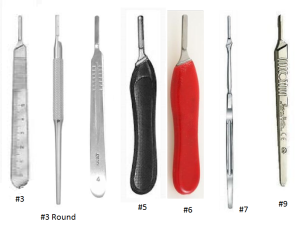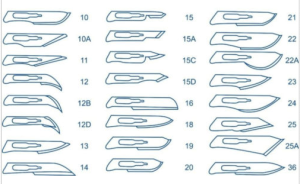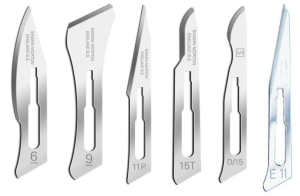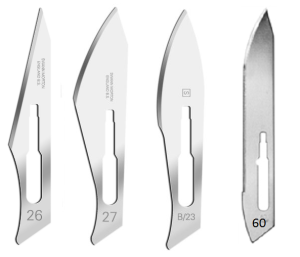Many small survival kits, in an effort to provide some form of cutting instrument, include a scalpel blade or two. The problem is, the term ‘scalpel’ is very broad. Most people do not know that there are several sizes and formats of handles, and a large number of blade shapes and types to choose from.
Most people do know that a scalpel, sometimes called a ‘lancet’, is a small, sharp knife used for precision cutting. The most common field which uses these is various forms of medical/dental/veterinary surgery and dissection, but scalpels are often used for crafts and hobbies as well. A person who is medically trained probably knows what each size and blade style is best used for. For the rest of us, here is an overview with a focus on survival kit application.
Many scalpels are two piece, that is, a handle and a blade. The blades are always considered disposable. You can find entire scalpels which are disposable; which is an option for medical usage, but not economical or space efficient for other survival usage. Packaging is either sterile or non-sterile. In my opinion, always go for sterile, as you can use sterile for any use, whereas a non-sterile blade or scalpel should not be used for any medical purpose. Blades are available in stainless steel or carbon steel, as well as a variety of edge treatments and/or coatings which probably are not worth the cost or effort to acquire. I would say that carbon steel would be a slightly better choice, since it can hold an edge better and when sterile packaged, is not subject to rust until well after being opened. But stainless steel is entirely adequate.
Handles and blades are generally identified by number in the format ‘#n’ for handles and ‘#nn’ for blades, but this is not universal. For example, there is one class of blades (‘heavy duty’) which are identified by letter in the range ‘S’ through ‘Z’. And several blades which mix letters and numbers.
In addition to the heavy duty class, there is a ‘large’ class usually referred to as ‘PM’ for Post Mortem (autopsy) and probably a ‘micro’ class, although the few references I saw seemed to indicate the latter were only available as one piece instruments. Besides, not much micro surgery is done under survival conditions… Most common though, are the small and medium classes. ‘Small’ class is based on the #3 handle, while ‘medium’ is based on the #4. Small blades are in the range of #06 through #17, while medium blades are in the range of #18 through #36 plus #60. There are probably other blades, but this will give us a start.
When choosing a blade, you want one which is as large as practical, with the most versatile blade shape. This is usually a drop point or straight clip blade. Leave them in their packaging, which will keep them protected from water and other sources of damage, will protect you from them, and if sterile, maintain that. If the blade is all that you have in the kit, you will want to have some tape or twine to wrap the mount end with, to somewhat improve your grip. It can also be fastened to a twig with wire or twine to provide a handle, or to the end of an arrow as a makeshift arrowhead. If you have room in the kit, you might include the appropriate handle to greatly improve your ability to use the blade(s).
UPDATE: I was building a smallish kit, and the #4 scalpel handle was just an inch or so too long to fit. I used a hacksaw to cut it to length (from the butt end of course) and a file to smooth and round the new end. It fit perfectly, and was still quite usable.
As mentioned, #3 handles fit smaller blades and are generally flat or occasionally round. A #5 handle fits the same blades, but is a much fatter handle; great for extensive cutting but probably too big for a survival kit. A #7 handle is also for the small blades, but is a sculpted shape. Finally. a #9 is a smaller handle for this size blade. The #4 handle is also flat or round, but for the medium blades. The #6 handle is the fatter version of the #4. The #8 handle is more commonly referred to as the PM8, and only works with PMxx blades. The ‘heavy duty’ handle does not have any designation other than its part number.
There is a bewildering assortment of blades available; here is a common chart:
And some photos of others not on the standard chart of blades:
These are not to scale; I doubt there is any reason to consider any small class blade for survival kit use, unless you are medically trained and are building or buying a surgical kit. Since this is generally for a small kit, without a handle, you want the biggest, most versatile blade. Very commonly included in commercial kits is the #22, which is a good blade. I think the #36 is a slightly better shape, and the 60 might be the longest of the medium class, if you have room. And can find it. If the #22/#36 are a bit too long to fit in your circumstances, the #21 or #18, respectively, might be a reasonable alternative.
There is allegedly also a #17 (‘chisel’ shaped) and #34 (a bigger version of #11), but I could not find examples or even pictures of them.
Here is the PM8 handle with the PM60 blade:
and the Heavy Duty handle and blades:
I like the look of the ‘S’ blade; I’ll try to get some in (they appear to only be available from England).







